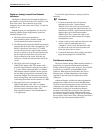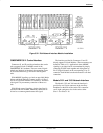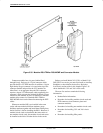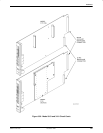
COMSPHERE 3000 Series Carrier
3-42 December 1994 3000-A2-GA31-80
Digital or Analog Leased-Line Network
Interfaces
The digital or analog leased-line network interface is
provided by two 50-pin connectors (P21 and P22) on the
back of the carrier. Each connector serves eight
contiguous slots in the carrier: one for Slots 1–8 and one
for Slots 9–16.
Depending upon your configuration, use one of the
following schemes for the digital/analog leased-line
interfaces (Figure 3-29):
• The 50-pin cable can be attached to a
66A-punchdown block. With this scheme, the
circuits must be hard-wired to the block.
• The DDS provider installs the RJ48T-type network
interface that the 50-pin cable is plugged into. The
RJ48T is specified to allow from 1 to 12 DDS
circuits to be placed on a single 50-pin connector.
Be sure to specify to the service provider that only
the first eight circuit positions are used in each
50-pin connection at the carrier. Note that you
cannot use a leased-line modem in this half of the
carrier.
• The 50-pin cable can be plugged into a
3600-F2-503 adapter cable. This adapter cable
provides 8 keyed modular connectors using Pins 1,
2, 7, and 8. These connect the DSU to a standard
DDS network interface (RJ48S) and also provide
the new JM8-style leased-line connection for the
leased-line modem. This interconnection scheme
allows mixing DSUs and leased-line modems only
if the analog leased-line network interface is a JM8.
• The 50-pin cable can be attached to the
3000-F1-009 adapter cable. This is a standard
DDS/leased-line connection in parts of Canada. It
provides eight 6-pin modular plugs. (This
interconnection scheme is not recommended for
U.S. application.)
To install the digital network or analog leased-line
interfaces:
Procedure
1. Connect the network cables (50-pin mass
termination line cable – feature number
3600-F2-503) to the carrier and use the small
screwdriver to engage and tighten the screw. For
installation in Canada, a special network interface
adapter cable is provided (feature number
3000-F1-009). First, connect the cables to the
carrier and use the small screwdriver to engage
and tighten the screw.
2. Attach a cable tie to the cable near the hood at the
carrier’s cable-tie attachment point. (If a
“straight-in” cable is used, disconnect the cable
tie, remove the screw and cable tie mount, and
fasten the cable with two screws.)
3. Connect the individual cables with 8-pin modular
plugs into the adapter for each DDS line.
Dial Network Interface
The direct distance dialing (DDD) network interface is
provided by two optional network interface modules
(NIMs) on the back of the carrier (Figure 3-28): an RJ21X
(permissive) or an RJ27X (programmable) 50-pin
connector. When there are two modules, they can be
different types of NIMs independent of one another.
Appendix A provides the pin assignments for these
connectors.
Additional features available for both programmable
and permissive NIMs are Service Line and Make Busy.
The Service Line feature permits an extra dial line to be
connected to the carrier. NIMs with this feature are
identified by two Service Line modular connectors
mounted on the NIM. The two Service Line connectors
are connected in parallel on the NIM board and can be
used in daisy chaining (sharing) a single dial line between
the two halves of the carrier (Slots 1 through 8 and Slots 9
through 16) and also between multiple carriers.


















